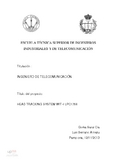Mostrar el registro sencillo del ítem
Head tracking system with LPC1758
| dc.creator | Sanz Cía, Gorka | es_ES |
| dc.date.accessioned | 2013-12-13T08:36:01Z | |
| dc.date.available | 2013-12-13T08:36:01Z | |
| dc.date.issued | 2013 | |
| dc.identifier.other | 0000578159 | es_ES |
| dc.identifier.uri | https://hdl.handle.net/2454/8764 | |
| dc.description.abstract | En este trabajo se presenta el diseño de un sistema head-tracking que puede ser utilizado como ratón de ordenador para personas con discapacidad. El sistema se compone de un microcontrolador LPC1758 integrado en la plataforma eStick2 desarrollada por la FH Technikum Wien, además de una cámara PAC7001 y un conjunto de 4 LEDs dispuestos en un prisma rectangular. El proyecto describe en detalle el proceso de desarrollo del software, describiendo los distintos pasos tomados, programas secundarios realizados para comprobar el funcionamiento de las distintas conexiones necesarias, como USB o UART, y los distintos problemas aparecidos así como el protocolo de activación de la cámara. Se ofrecen también los distintos resultados de las mediciones realizadas para el sistema head tracking y conclusiones al respecto de esas mediciones. En conclusión, en este trabajo se analizan las limitaciones de la configuración seleccionada y se cuestiona su idoneidad para la función deseada. | es_ES |
| dc.description.abstract | The aim is to create a program that controls a head tracking system for disabled people. The system is composed by a PAC7001 camera, the LPC1758 microcontroller integrated in to the eStick2 platform and a set of infrared LEDs. To attain this objective, UART and USB connections are used, and the POSIT algorithm also has a relevant role in the final achievement of the software. In this paper the process of doing the software of the head tracking system and the different programs built to finally obtain this software are described. These programs are used to understand how the USB or the UART connection worked, to check how the pointer of the mouse is moved or to see the data captured by the PAC7001 camera and how these data had to be treated. The different problems that appeared during the programming are described, how they have been solved and also the final result. Finally it is discovered that it was no possible to build a program that worked properly with the components used and some advices for future improvements are given. | en |
| dc.format.mimetype | application/pdf | en |
| dc.language.iso | eng | en |
| dc.subject | Sistemas head tracking | es_ES |
| dc.subject | Cámaras PAC7001 | es_ES |
| dc.subject | Microcontroladores LPC1758 | es_ES |
| dc.subject | Head tracking systems | en |
| dc.subject | PAC7001 cameras | en |
| dc.subject | LPC1758 microcontrollers | en |
| dc.title | Head tracking system with LPC1758 | en |
| dc.type | Proyecto Fin de Carrera / Ikasketen Amaierako Proiektua | es |
| dc.type | info:eu-repo/semantics/masterThesis | en |
| dc.contributor.affiliation | Escuela Técnica Superior de Ingenieros Industriales y de Telecomunicación | es_ES |
| dc.contributor.affiliation | Telekomunikazio eta Industria Ingeniarien Goi Mailako Eskola Teknikoa | eu |
| dc.contributor.department | Ingeniería Eléctrica y Electrónica | es_ES |
| dc.contributor.department | Ingeniaritza Elektrikoa eta Elektronikoa | eu |
| dc.description.degree | Ingeniería de Telecomunicación | es_ES |
| dc.description.degree | Telekomunikazio Ingeniaritza | eu |
| dc.rights.accessRights | info:eu-repo/semantics/openAccess | en |
| dc.rights.accessRights | Acceso abierto / Sarbide irekia | es |
| dc.contributor.advisorTFE | Serrano Arriezu, Luis Javier | es_ES |


